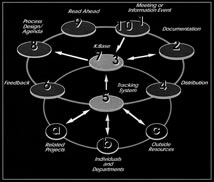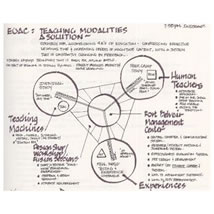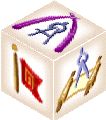d e s i g n 22 s p e c i f i c a t i o n s
p a r t s2so fs 3
|
• part one of three • part three of three • |
Functional Process Components |
| The seven Functional Process Components outlined above will be described here in relation to the 7 Domains Model and its application to the UniCredit NavCenter as a specific design. The requirements which these Components impose on the design of the NavCenter and its s sub-systems will be detailed in the following section. |
Component 1
| Knowledge creation, capture, storage, retrieval and employment, as an integrated way of working throughout the UniCredit enterprise |
|
| Organized knowledge - intellectual capital - is an organization’s most valuable asset not people - their combined knowledge organized and appropriately augmented by technology and put to effective use in a market, is the prize. People are not an asset as they cannot be owned and are free agents. Knowledge “management” is a term which I do not like - working knowledge is a far better notion. Knowledge happens when experience held in active memory, an intellectual frame work and structure, purposeful intent are combined by action in action aimed at the accomplishment of a goal. Outside this algorithm, there exists only information, passive memory and theories. Knowledge has to be worked to be knowledge and to remain knowledge. Humans have an innate ability to acquire and employ knowledge. Of course, the skills to do this have to be learned and some do it better than others. However, all do create and use knowledge. Organizations do not come with this capability. It has to be deliberately build by the design and use of a technical system effectively combined and integrated with human work protocols. This is illustrated in MG Taylor’s 10 Step Model. |
 |
Click on the diagram to go to a description of the 10 Step Model.
The 10 Step process is a disciple which cuts across all of the traditional boundaries of an organization. |
|
| The 10 Step Process is a systematic engine designed to “chunk” individual, disbursed, usually fragmented experiences into an integrated working capability. It is designed to do for organizations what a brain does for an individual. It is an essential requirement of GroupGenius. It is missing from most organizations thereby wasting the mental bandwidth of most of their members. |
| This “brain of the organization” requires that computers and media be integrated and used in ways which augment human cognition. To date, most applications of these technologies have been employed to automate useful but fragmented and old work processes. The UniCredit NavCenter requires true augmentation to do its work and can serve as a lab for the development and distribution of this way of working throughout UniCredit. |
| It is “installing” the habit of documentation, systematic knowledge-sharing and appropriate use of “meetings” that is the benefit of Component 1 to the UniCredit NavCenter users. This requires that the tools we accessible and fit with the cognitive styles of each individual user. It requires that all media - from a pencil and paper to large-scale medial presentations - be seen as multimedia. |
Component 2
| Teaching, facilitating and putting to strategic and daily practice, collaborative design skills promoting a culture of GroupGenius® |
|
| Humankind is creating a global, knowledge-based, network architecture economy where the primary value add is design. The design of products and services; the design of markets; the design of complex technical and work process systems; ultimately, the design of our Planet, our civilization and ourselves. Aspects of all these examples all are in the labs and on the drawing boards today. Design competency is no longer the purview of a few, it is a task of the many. This competency is not defined just in terms of making things but in the design and making of organizations themselves. Competency is also to be understood in the sense of employing the designs of others - configuring acquired tools and processes in order to make new ones. The attitude and skill set of the designer is not common in organizations today. The underlying capability is, however, but it is not recognized, supported nor generally rewarded outside of a few narrowly defined areas. |
| In the making of the modern corporation, markets, products, communities and the sum of it which we call our world, we are talking about the design of very complex systems. In these examples design cannot be understood as a simple linear process. The future requires the design of complex emergent systems and this requires the expertise of many not a few. This requires unprecedented levels of collaboration. Sustainable success requires GroupGenius. GroupGenius is not individual genius “added up.” GroupGenius is not incompatible with individual genius as many suppose; it does, however, run by its own rules. Genius is not rare as the common legend would have it. The environment of organizations (the physical place, the work processes, the technology) discourages its flowering. The mission of the NavCenter is to nurture and release GroupGenius and promote its spreading throughout UniCredit. |
Component 3
| Being a knowledge intensive, networked physical/virtual work environment making Unicredit human capital requisite with future change and complexity |
|
Component 4
| Transferring the skills of knowledge-work, networking, weak signal research, project management, strategic thinking as a distributed, pragmatic work habit |
|
Component 5
| Inventing and sustaining the concept of the venture and integrating each individual’s learning program directly to their present and future work |
|
 |
| Click on the diagram to go to a description of the Education Engine Model. |
|
| Education for too long has been relegated to the sidelines of life as something you do in your youth in order to “get” a job and “earn a living.” While not denying the relationship between learning and productive work and, thus, income, education is clearly a life long endeavor with a much more lofty goal than preparing one only for a life of commerce. The notion that you are “done” - like a medium rare steak, I suppose - at the end of this youthful sojourn is greatly flawed in context of a knowledge-network-design economy undergoing one transformation after another. Businesses having long decided that the university alone cannot supply them with the qualified people they require. And, businesses long ago discovered the need for continuing learning. In many countries, businesses expense for “training” exceeds the cost of their county’s entire education budget through all grades including universities. |
| A new set of assumptions have to be in place in order to design effective educational experiences [link: education model - process]; and, these.... |
Component 6
| Tracking, distributing and re-using key knowledge and insuring knowledge succession through projects which build necessary corporate cognitive capacity |
|
Component 7
| As a physical metaphor of Unicredit, employ simulations, multimedia, design experiences and embed this image in the memory of Unicredit and its entire ValueWeb |
|
|
goTo: Part Three of Three |
|
| Return to INDEX Matt Taylor Biography |
|
|
|
|
| Return to INDEX Unicredit Academy |
|
|
|
|
| GoTo: UniCredit NavCenter INDEX |
|
|
|
|
| Link: Project Phasing Options |
|
|
|
|
| GoTo: ver 2.5 Line Drawings INDEX |
|
|
|
Matt
Taylor
Milan
February 14, 2006

SolutionBox
voice of this document:
ENGINEERING • STRATEGY • PRELIMINARY
|
|
|
posted:
February 14, 2006
revised:
March 24, 2006
• 20060214.421988.mt • 20060214.341908.mt •
• 20060216.333300.mt • 20060202.546300.mt •
• 20060324.657200.mt •
Copyright© 1987, 2006 Matt Taylor
(note:
this document is about 20% finished)
|
|